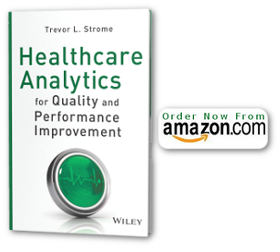The readers of this blog will know that I’ve written in the past about “tactical analytics” – that level of analytics support that sits between strategic analytics and operational analytics.
Of course, strategic analytics is most commonly used by healthcare executives and program leadership to monitor performance targets and facilitate resource planning. And, operational analytics are focused on the day-to-day operations of the departments, programs, or hospitals.
Tactical analytics, as I have seen employed quite effectively, consist of actionable information that helps process improvement teams assess specific improvement goals. Typically, the questions that tactical analytics can help answer are:
- Are we achieving our performance/quality improvement goals?
- What do we need to do to improve our quality / performance?
Tactical analytics can help “thin-slice” the information needed to address specific quality and performance issues such as bottlenecks in patient flow.
In my experience, I have noticed that the following conditions must be met in order for tactical analytics to be effective:
- Recent: Information provided by analytics tools must be recent enough to address specific performance issues (including down to individual staff level), so it must be available in real-time or daily (at a minimum).
- Relevant: For information to be actionable (that is, identify the likely root cause of a problem), the metrics being reported must clearly pertain to the issue being addressed and presented in a manner that is meaningful to the end-users of the information.
- Right: The quality and accuracy of information must be excellent, otherwise end-users will question whether changes in the data are reflecting actual performance, or merely the result of spurious fluctuations in the data.
In addition to the above requirements, the analytics must be available to those who can take action based on the information. At the very least, the performance information should be made available to those whose work is impacted by process changes, as well as to their managers and other coaches who can monitor and encourage sustainable process change.
Presentation of tactical analytics can consist of daily performance reports posted on the quality board (every healthcare organization has a quality board, right?), or can be as sophisticated as real-time performance dashboards available through quality and performance improvement online portals. Regardless of how information is made available, it must be accessible to those to whom it matters in a timely enough manner to reinforce positive performance changes.

{ 0 comments… add one now }